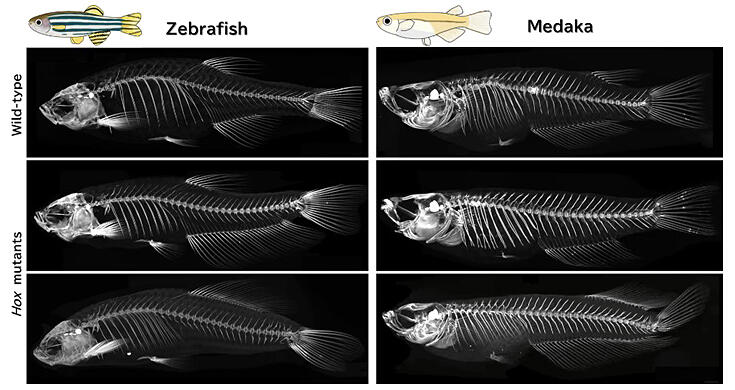Associate Professor Akinori Kawamura, Graduate Student Urara Adachi, Assistant Professor Hiroyuki Furudate, and their colleagues at the Graduate School of Science and Engineering at Saitama University, in collaboration with Professor Masaru Matsuda and Project Associate Professor Norimasa Iwanami at the Center for Bioscience Research and Education at Utsunomiya University, and the National Institute of Genetics have announced their research findings revealing that the position at which fish fins are formed is regulated by the Hox genes. They found that partial changes in the Hox gene system are responsible for the diversification of fin positions and widths. The results were published in the June 11 issue of the Proceedings of the National Academy of Sciences of the United States of America "PNAS."

Provided by Saitama University
Fish fins can vary widely from species to species, and fin width, position, and size are characteristic of a species. However, the mechanisms underlying the diversification of the fins remained unknown until now. The research group focused on Hox genes, which provide positional information in animal development. Hox genes are numbered from 1 to 13. The gene designated number 1 works on the head side, and the remaining genes are responsible for a more caudal part of the body as the number increases. Therefore, they analyzed the effects of disrupting the function of various Hox genes in zebrafish.
The results showed that the regions where "dorsal fins" and "anal fins" are formed are segmented by different Hox genes. Moreover, Hox genes were arranged in numerical order along the anterior−posterior axis of the body. Subsequently, a similar analysis of medaka was conducted. Medaka and zebrafish are classified in the same division, Teleost, but are evolutionarily distant from each other. Unlike zebrafish, medaka have anal fins anterior to their dorsal fins and might not follow the regularity of expression segments in the numbering order. The results of this analysis showed that the Hox genes responsible for the formation of dorsal fins were different between medaka and zebrafish and that the regularity of the Hox genes in the "numbering order" is maintained in medaka.
The common ancestor of the zebrafish, medaka, and other related species appeared in the late Silurian. It is believed that primitive fish of that time had the dorsal and anal fins in the same position and that fish with the two fins in separate positions occurred later. This study proposed a new model in which the positions of formation of the fins diverged in fish during evolution by switching one Hox gene to another. The findings are expected to contribute to the creation of cultured and ornamental fish with artificially modified shapes.
Kawamura said, "When I saw a zebrafish with its dorsal fins spread more than three times, I felt the profoundness of the animal. This study has shown that the Hox genes determine the position of fin formation. Our future challenge is to determine, at the DNA level, how the Hox genes work differently across fish species in which positions of fin formation differ. Once we understand that, I think that a day will come when we will be able to design the shape of fish as we wish."
Journal Information
Publication: PNAS
Title: Teleost Hox code defines regional identities competent for the formation of dorsal and anal fins
DOI: 10.1073/pnas.2403809121
This article has been translated by JST with permission from The Science News Ltd. (https://sci-news.co.jp/). Unauthorized reproduction of the article and photographs is prohibited.




